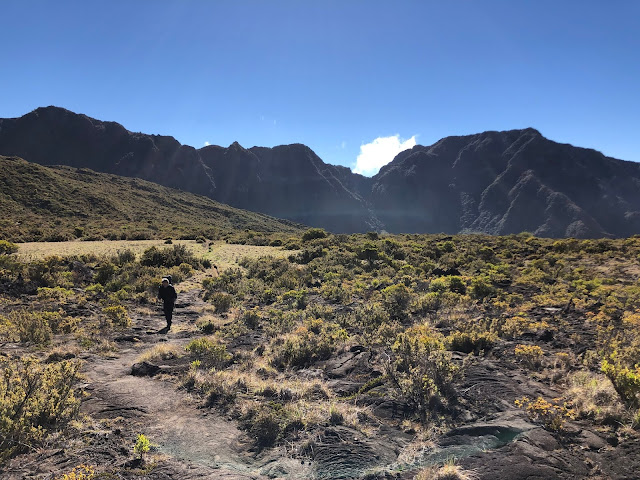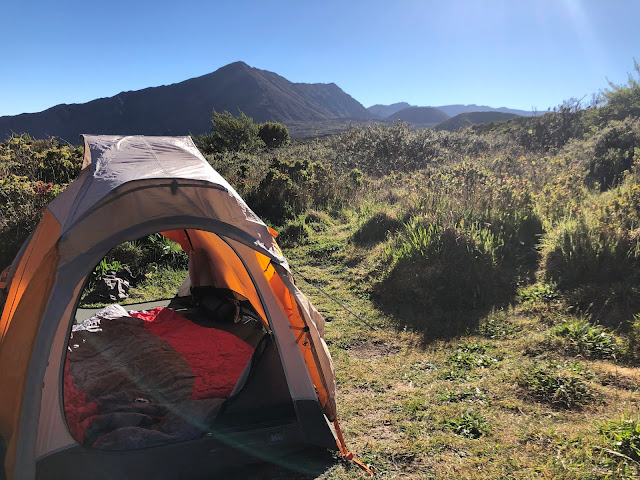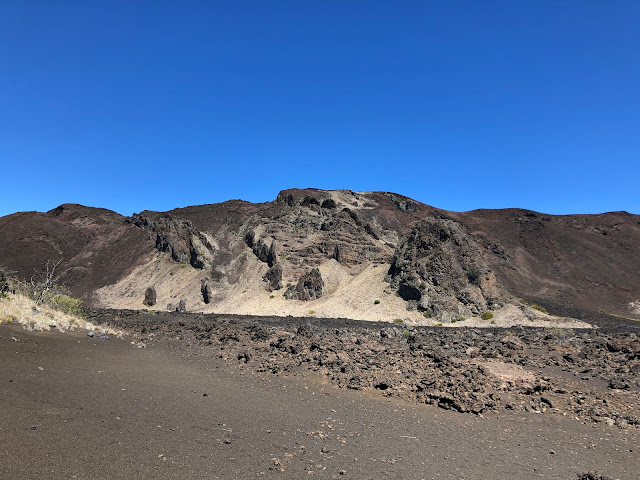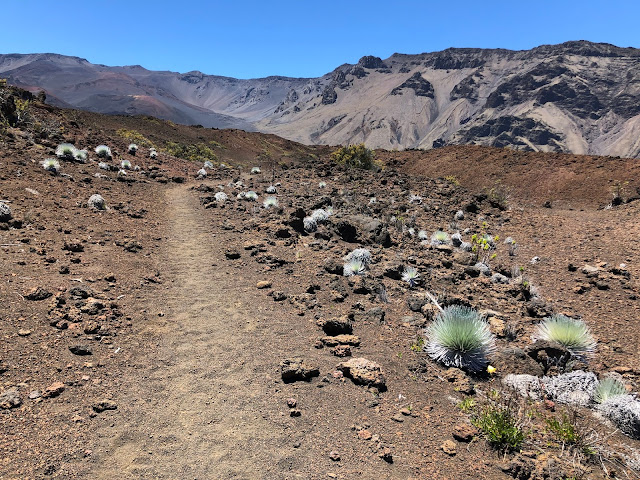
Technically the Haleakala crater isn't a crater because it's not bounded on all sides. It's an erosionary depression with new cinder cones growing up and up. I'm going to just call it a crater because it's easier. I found an article on this hike shortly after moving to Hawaii. The logistics were such that I put it off until Dad was looking for a little adventure. None of us had been backpacking in a while, and Lorrie was brand new to the sport. (Spoiler: she did great!) I stressed myself out reading everything I could find on the hike. It was actaully fairly hard to find info if you're not staying in the cabins. So, I included it here in case anyone other than my mom reads this post. (Hi Mom!)

Permits are required to camp and are given out at the visitor center on a first come first served basis. You can pick them up day before or day of your hike. They are free with your park entry fee or annual pass. There are a limit to the number they give out, but it's rare for them to sell out. There are three cabins with pretty much anything you could want for camping, but they book up fast and cost $75 per night. Each cabin is rented to one group only and can hold up to 12 people. We didn't stay in cabins, though. We stayed in tents. Camping is available near two of the cabins, Paliku (9.8 miles from the Sliding Sands trailhead) and Holua (3.9 miles from the Halemau'u trailhead).

Some people choose to do this hike the hard way and start at Holua. We chose the downhill route. This meant Mike dropped us off at the Sliding Sands trailhead with all of our packs. He drove the car down to the Halemau'u trailhead and hitchhiked back up. This was one of the logistical pieces I was worried about. Turns out, it was no big deal. In no time, Mike came cruising up in the back seat of a bright red convertible Mustang looking for all the world like he expected such a stylish ride. It was the first car that passed that picked him up. Since it's a dead end road to the top, I think people are more likely to give hikers a lift. You definitely want to do this at the beginning of the trip. No one will want to pick you up after three days of hiking and no baths.

As soon as Mike arrived, we set off along Sliding Sands trail down into the Mars-like landscape. The trail has panoramic high desert views the entire way to the base of the crater. The sand is finely crushed volcanic rock of varying colors based on age: black, gray, orange, and red. Beautiful little succulent-like plants called silverswords break up the landscape here and there. Silverswords are unique to Haleakala and only grow around 8000 feet in elevation. They're actually in the sunflower family. So, they're not succulents. I'm just full of useful trivia today.

The first cabin is Kapaloa. It sits in a grassy meadow under the rim of the mountain. It has water and an outhouse, which are both kind of nice to have after 5.6 miles of dusty walking. Remember, water needs to be filtered. The taps are outside of the cabins (another of the answers I struggled to find). We sat at the picnic table out front, had some snacks and watched a nene (Hawaii's endemic goose) and some chukar birds wandering around looking for crumbs. This was the first view of actual life inside the crater.

The next part of the trail was a field of dark gray a'a (rough lava formed by splatter rather than flow) that was starting to grow in with plants. The contrasting colors with the vivid blue sky made this a favorite section of the trail for me.

Eventually the landscape turned to grasses and actual trees as we neared the campsite. The Paliku cabin is at the base of one of the crater walls. The wall itself has trees growing all over it. It's pretty impressive. At this point we're above the clouds. We chose two campsites and set up our tents in the grasses. Everyone was pretty tired. We made simple dinners of pouched chicken and instant mashed potatoes with the jet boil. The minute the sun went down the temperature plummeted and we retreated to our sleeping bags for warmth. We woke later to a sky full of stars. There was some sort of haze in the air that made it almost look like static.

The next morning we woke up to frosted tents. We packed our stuff, topped off our water and walked the 6.5 miles to Holua Camp. The trail takes the opposite side of the a'a field and across the Ko'olau Gap. The a'a field on this side has far less flora. At the end of the field the earth turns to dark gray sand. Against the crater rim, big jagged rocks split the hillside looking for all the world like a laying down dinosaur with stegosaurus plates ,amiright? No? Like the big boulder is the head, and the tail trails off up the hill on the left side? Ok, fine. I'm an adult child, I get it.

Shortly after that section I took a step and nearly squished a big wolf spider. On closer inspection she was carrying tons of babies on her back. Way cool! The spider, with legs included, was about the length of my pointer finger. I'm super glad that wasn't in my house/bed/sleeping bag, but was cool to see along the trail. We were back to the gray and red sands when we found this gorgeous painted section.

The trail took us through the Ko'olau Gap's dark sands with little bits of lava strewn here and there to a little side trail called the Silversword loop. It lived up to its name and was totally worth the extra .1 mile it added to the trip.

Walking into Holua camp was similar to the other side, but with more lava rock. The plants started coming up and the views were, of course, spectacular. The cabin came into view a short distance later. There's a little cave above the cabin big enough for an emergency holdout for a couple of people. The campground is actually not next to the cabin. It's up a hill further than you'd actually think to walk. Our site was surrounded by a little fairy ring of black a'a and backed by the giant wall of the crater. There's an outhouse up there and a stable for the horse tours that operate occasionally. We're still mostly above the clouds here, but the winds brought in airy clouds and mists that occasionally socked us in completely.

We arrived early enough to enjoy the area for a bit. Mike and I played with the drone for a bit. A few large groups of day hikers came and went. We set up camp, had an early dinner, talked over tea. The sunset didn't bring on the cold like the previous night. It was pleasant, but once the sun goes down, there's no real reason to be awake since campfires aren't allowed. Mike woke me up around 3 AM to check out a clear sky full of incredible stars. Whatever haze had blocked the view the previous night was gone. The stars were clear, bright, focused. We could see the Milkyway arcing across the horizon. Between the new moon and the low cloud cover, no light dulled our view. It's crazy to realize how much there is to see when you fully escape human influence. Being in the middle of the ocean has its advantages.

The following morning took us along a ton of switchbacks up Halemau'u trail back to the car. It was a beautiful and remarkably comfortable hike for its elevation gain. Every switchback brought fantastic views across the crater. The car was right where Mike left it, undisturbed. The trip went super smoothly.

We grabbed lunch (real food!) at Grandma's in Kuya. Then we checked out a nearby lavender farm, which was beautiful and fragrent. Finally, we took a dip in the ocean to clean some of the dirt off. It felt amazing!

Things to note: Hawaiian doesn't allow trekking poles as a carry-on. It also doesn't allow camp stoves or fuel. Mokulele, on the otherhand, let us take both. The ride is far more awesome too. Support the little guy! We picked up jetboil fuel at Maui Adventure Sports in Kahului. We flew in the night before and stayed the night. The other option is to fly in morning of the hike. There's plenty of time. The sun is super intense, so I strongly suggest hat, glasses, hood, long sleeves and sunscreen. Our lips were totally chapped for a few days after. Sunscreen them and use chapstick. Oh, and don't forget to charge your phone or camera. I took over 500 photos in three days.
